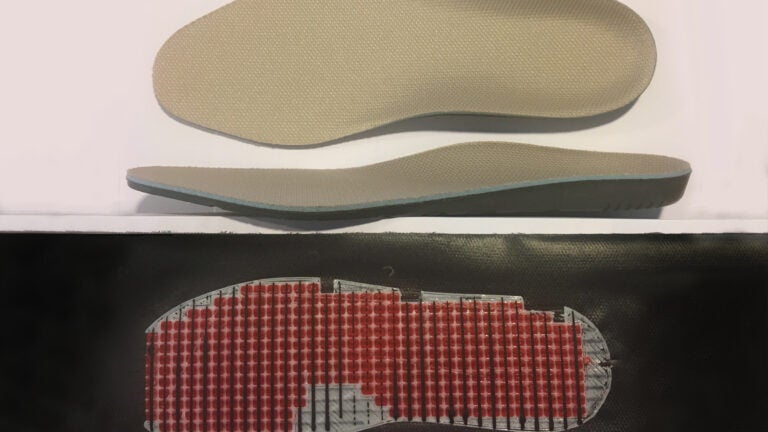
The smart insole can measure gait, activity level and balance and detect a rising temperature which could be a sign of infection. The project is the result of a collaboration between a podiatric surgeon and a neurosurgeon. (Image/Courtesy of Bernard Grisoni, Autonomous ID)
Doctors who focus on the foot and brain team up on a smart insole
The device will flag changes in a patient’s gait and perhaps detect an infection
Professors David Armstrong and Charles Liu at first seemed to be an unlikely pair.
But the podiatric surgeon and neurosurgeon clicked on a personal level and promptly realized they had a lot to offer each other as Keck School of Medicine of USC collaborators.
Both were already studying how much information a person takes in through the nerves of the feet, how to preserve, repair or replace that information system, and how nerve damage can affect a patient’s mobility.
Armstrong is interested in metabolic health, mobility and neuropathy — the loss of nerve sensitivity that can occur in patients with diabetes, Liu noted.
“As a neurosurgeon, I’m interested in lower-extremity function and metabolic health, too,” he said. “In my work, I think about how to restore mobility to patients who can’t feel their legs. It’s a similar problem to diabetic foot ulcers.”
Armstrong added: “We’re meeting in the middle, and it’s fun. It’s so common in medicine for people to silo, but you can’t let your ideas sit there alone. Whatever the other guy is doing will make your thing more interesting.”
Smart insole, smart physicians
The two started looking for a project on which to collaborate. Oddly enough, they found it with a Canadian security company. The firm was working with the idea of capturing pressure signatures — the way weight is distributed across people’s feet as they walk — which are as distinctive as fingerprints. At the time, the company was working with technology that could signal if, for example, an unknown person walked into a secure room.
The doctors soon saw that pressure signatures could be a way to spot changes in a person’s gait early on — a potential warning sign of a more serious problem. With their shared interest in wearable technology, Armstrong and Liu steered the company toward a smart insole. The device will flag changes in a patient’s gait, activity level and balance, as well as monitor for the localized increase in heat that can reveal a building infection before the human eye can spot it.
The best surgery is the one we never have to do.
David Armstrong
“Those early warning signs can be crucial — the best surgery is the one we never have to do,” Armstrong said.
Rewarding patients
With such prevention in mind, the “toe doctor and the brain doctor” increase the functionality of the insole to have it reward patients for increasing their activity or losing weight, make nutritional recommendations or discreetly remind a patient to get his or her daily walk in. Their work has the potential to give patients a sense of greater contact with their care team while reducing the need for physical office visits.
And the collaboration caught fire: The insole tied for first place for the Global People’s Choice Award in this year’s Diabetes Innovation Challenge run by T1D Exchange.
“Every once in a while, you need to win an award,” Liu joked. “Diabetes is a huge problem in the world. In the tech world, people pitch their ideas. If these technologies are identified as being worthy, you can start to get the support.”



